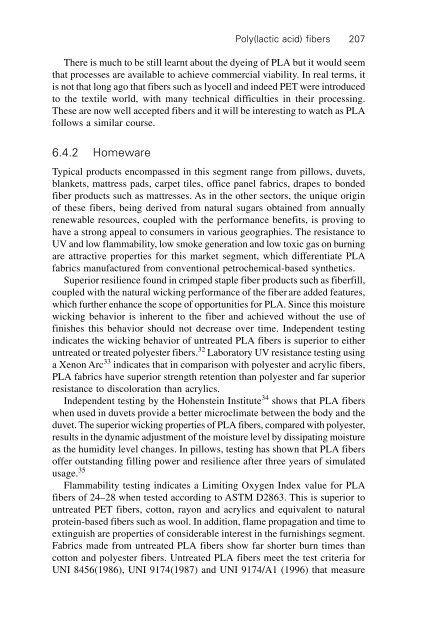Poly(lactic acid) fibers - Jim Lunt LLC
Poly(lactic acid) fibers - Jim Lunt LLC
Poly(lactic acid) fibers - Jim Lunt LLC
- No tags were found...
You also want an ePaper? Increase the reach of your titles
YUMPU automatically turns print PDFs into web optimized ePapers that Google loves.
<strong>Poly</strong>(<strong>lactic</strong> <strong>acid</strong>) <strong>fibers</strong> 207There is much to be still learnt about the dyeing of PLA but it would seemthat processes are available to achieve commercial viability. In real terms, itis not that long ago that <strong>fibers</strong> such as lyocell and indeed PET were introducedto the textile world, with many technical difficulties in their processing.These are now well accepted <strong>fibers</strong> and it will be interesting to watch as PLAfollows a similar course.6.4.2 HomewareTypical products encompassed in this segment range from pillows, duvets,blankets, mattress pads, carpet tiles, office panel fabrics, drapes to bondedfiber products such as mattresses. As in the other sectors, the unique originof these <strong>fibers</strong>, being derived from natural sugars obtained from annuallyrenewable resources, coupled with the performance benefits, is proving tohave a strong appeal to consumers in various geographies. The resistance toUV and low flammability, low smoke generation and low toxic gas on burningare attractive properties for this market segment, which differentiate PLAfabrics manufactured from conventional petrochemical-based synthetics.Superior resilience found in crimped staple fiber products such as fiberfill,coupled with the natural wicking performance of the fiber are added features,which further enhance the scope of opportunities for PLA. Since this moisturewicking behavior is inherent to the fiber and achieved without the use offinishes this behavior should not decrease over time. Independent testingindicates the wicking behavior of untreated PLA <strong>fibers</strong> is superior to eitheruntreated or treated polyester <strong>fibers</strong>. 32 Laboratory UV resistance testing usinga Xenon Arc 33 indicates that in comparison with polyester and acrylic <strong>fibers</strong>,PLA fabrics have superior strength retention than polyester and far superiorresistance to discoloration than acrylics.Independent testing by the Hohenstein Institute 34 shows that PLA <strong>fibers</strong>when used in duvets provide a better microclimate between the body and theduvet. The superior wicking properties of PLA <strong>fibers</strong>, compared with polyester,results in the dynamic adjustment of the moisture level by dissipating moistureas the humidity level changes. In pillows, testing has shown that PLA <strong>fibers</strong>offer outstanding filling power and resilience after three years of simulatedusage. 35Flammability testing indicates a Limiting Oxygen Index value for PLA<strong>fibers</strong> of 24–28 when tested according to ASTM D2863. This is superior tountreated PET <strong>fibers</strong>, cotton, rayon and acrylics and equivalent to naturalprotein-based <strong>fibers</strong> such as wool. In addition, flame propagation and time toextinguish are properties of considerable interest in the furnishings segment.Fabrics made from untreated PLA <strong>fibers</strong> show far shorter burn times thancotton and polyester <strong>fibers</strong>. Untreated PLA <strong>fibers</strong> meet the test criteria forUNI 8456(1986), UNI 9174(1987) and UNI 9174/A1 (1996) that measure


